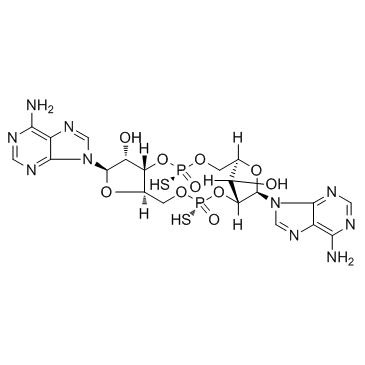| Description |
ADU-S100 is an inducer of STING (stimulator of interferon genes). ADU-S100 has enhanced binding affinity to STING and activate all known human STING alleles.
|
| Related Catalog |
|
| Target |
STING[1]
|
| In Vitro |
ADU-S100 shows enhanced type I IFN production over CDA in THP-1 human monocytes. In contrast, the dithio, mixed-linkage cyclic dinucleotide (CDN) derivatives (ML RR-CDA, ML RR-S2 CDG, and ML RR-S2 cGAMP) potently activate all five hSTING alleles, including the refractory hSTINGREF and hSTINGQ alleles. ADU-S100 induces the highest expression of IFN-β and the pro-inflammatory cytokines TNF-α, IL-6, and MCP-1 on a molar equivalent basis, as compared to endogenous ML cGAMP and the TLR3 agonist poly I:C. ADU-S100 is also found to induce aggregation of STING and induce phosphorylation of TBK1 and IRF3 in mouse bone marrow macrophage (BMM). ADU-S100 induces significantly higher levels of IFN-α when compared to ML cGAMP[1].
|
| In Vivo |
ADU-S100 shows higher anti-tumor control than the endogenous ML cGAMP. A dose response of the ADU-S100 compound is performed in B16 tumor-bearing mice, which identifies an optimal antitumor dose level that also elicites maximum tumor antigen-specific CD8+ T cell responses, and improves long-term survival to 50%[1].
|
| Cell Assay |
Cryopreserved hPBMCs are thawed and 1×106 cells per well are plated in a 96 well plate in RPMI media supplemented with 10% FBS, 1% non-essential amino acids, 1% penicillin/streptomycin, L-glutamine, 10 mM HEPES buffer, 1 mM Sodium Pyruvate, 0.055 mM β-ME at 37°C with 5% CO2. Cells are stimulated with 10 μM ADU-S100 or ML cGAMP for 6 hours and supernatants are harvested. Supernatants are diluted 1:2 and assayed for IFN-α protein using Cytometric Bead Array (CBA) Human Flex Set. Data is collected using a FACSVerse cytometer and analyzed by FCAP Array Software[1].
|
| Animal Admin |
Mice[1] WT C57BL/6 mice are inoculated with 5×104 B16.F10 cells in the left flank (n=8). When tumor volumes are 100 mm3 mice receive three IT doses of either ML RR-S2 CDG (25 μg), ADU-S100 (50 μg), or HBSS as control. WT C57BL/6 mice are inoculated with 5×104 B16.F10 cells in the left flank (n=5). When tumor volumes are 100 mm3 they received three IT doses of ADU-S100 at 5, 25, 50 or 100 μg or HBSS as control. WT C57BL/6 mice are inoculated with 5×104 B16.F10 cells in the left flank (n=8). When tumor volumes are 100 mm3 they receive three IT doses of 100 μg ADU-S100 or HBSS as control. Treatments are administered on days 13, 17 and 20 and tumor measurements are taken twice weekly. Results are shown as percent survival by Log-rank (Mantel-Cox) test (A and C)[1].
|
| References |
[1]. Corrales L, et al. Direct Activation of STING in the Tumor Microenvironment Leads to Potent and Systemic Tumor Regression and Immunity. Cell Rep. 2015 May 19;11(7):1018-30.
|


